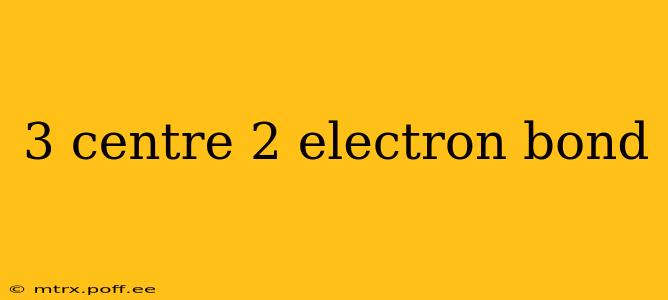A 3-center 2-electron (3c-2e) bond is a type of covalent bond where three atoms share two electrons. Unlike conventional 2-center 2-electron bonds (like the single bonds in methane), these bonds involve delocalized electrons spanning three atoms. This leads to unique properties and structures observed in certain molecules, especially those containing boron or bridging hydrogen atoms. Understanding 3c-2e bonds is crucial for comprehending the chemistry of electron-deficient compounds and certain reaction mechanisms.
What are the Characteristics of a 3-Center 2-Electron Bond?
The defining feature of a 3c-2e bond is the involvement of three atoms sharing only two electrons. This contrasts with typical covalent bonds where two atoms share two electrons. This electron deficiency often leads to a weaker bond compared to conventional 2c-2e bonds. The bond strength is also influenced by the electronegativity of the atoms involved.
The electron pair in a 3c-2e bond is delocalized across the three atoms, meaning it's not localized between any two specific atoms. This delocalization is key to understanding the stability of molecules containing these bonds. We often represent these bonds using a curved line connecting the three participating atoms, visually illustrating the delocalization.
Where are 3-Center 2-Electron Bonds Found?
3c-2e bonds are prevalent in several classes of compounds, most notably:
-
Boron Hydrides (Boranes): These compounds are a prime example, showcasing the classic 3c-2e bonding. The simplest borane, diborane (B₂H₆), contains two 3c-2e bonds bridging the two boron atoms. This unusual structure allows boron, with only three valence electrons, to achieve a stable octet configuration.
-
Transition Metal Complexes: Certain metal complexes can exhibit 3c-2e bonding, particularly those involving bridging hydrogen atoms. The hydrogen atom acts as a bridge between two metal centers, with the electrons delocalized across all three.
-
Other Electron-Deficient Compounds: While less common, other electron-deficient molecules can exhibit 3c-2e bonding as a way to stabilize themselves and achieve a more favorable electron configuration.
How do 3-Center 2-Electron Bonds Form?
The formation of a 3c-2e bond involves the overlap of three atomic orbitals, typically one from each of the three participating atoms. One orbital contributes one electron, while the other two provide the remaining electron. These atomic orbitals combine to form three molecular orbitals: one bonding orbital (lowest in energy), one non-bonding orbital, and one antibonding orbital (highest in energy). The two electrons occupy the bonding molecular orbital, creating the 3c-2e bond.
What is the Difference Between a 3-Center 2-Electron Bond and a Conventional Covalent Bond?
The fundamental difference lies in the number of atoms involved in the bond and the electron distribution. A conventional covalent bond involves only two atoms sharing an electron pair localized between them. In contrast, a 3c-2e bond involves three atoms sharing two electrons delocalized across all three. This delocalization is the key distinction, leading to different bonding characteristics and molecular geometries.
Are 3-Center 2-Electron Bonds Strong or Weak?
The strength of a 3c-2e bond is generally weaker than a conventional 2c-2e bond. However, it plays a crucial role in stabilizing molecules that would otherwise be unstable due to electron deficiency. The bond strength depends heavily on the participating atoms' nature and their relative electronegativities.
How are 3-Center 2-Electron Bonds Represented?
In Lewis structures, 3c-2e bonds are usually represented by curved lines connecting the three atoms involved. This differs from the straight lines typically used to represent conventional 2c-2e bonds. More advanced representation employs molecular orbital diagrams, explicitly showcasing the molecular orbitals and electron occupancy.
This comprehensive overview sheds light on the intricacies of 3-center 2-electron bonds, showcasing their significance in the context of diverse chemical compounds and their unique contribution to molecular stability and structure. Further research into specific examples, such as diborane's structure and bonding, will offer a deeper appreciation of this crucial bonding type.
